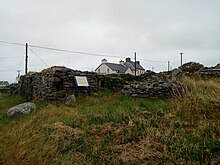Templesaghtmacree
| Templesaghtmacree | |||||||||
|---|---|---|---|---|---|---|---|---|---|
Teampall na Seacht Mac Rí[1] | |||||||||
 | |||||||||
| 53°05′02″N 9°35′25″W / 53.083866°N 9.590158°W | |||||||||
| Location | Carrownlisheen, Inishmaan, County Galway | ||||||||
| Country | Ireland | ||||||||
| Denomination | Roman Catholic | ||||||||
| Architecture | |||||||||
| Functional status | inactive | ||||||||
| Years built | c. 8th–10th centuries AD | ||||||||
| Specifications | |||||||||
| Length | 10.85 m (35.6 ft) | ||||||||
| Width | 4.95 m (16.2 ft) | ||||||||
| Number of floors | 1 | ||||||||
| Floor area | 53.7 m2 (578 sq ft) | ||||||||
| Materials | limestone | ||||||||
| Administration | |||||||||
| Diocese | Tuam | ||||||||
| |||||||||
Templesaghtmacree is an Early Christian church and National Monument located on Inishmaan, Ireland.[2][3]
Location
[edit]Templesaghtmacree is located right in the centre of Inishmaan, the middle Aran Island. It is directly east of the modern Catholic church, the Church of Our Lady and St John.[4]
History
[edit]The name is derived from the Irish language, meaning "Church of the Seven King's Sons,"[5][6] commemorating seven men of royal birth who came to Inishmaan as hermits.[7] It was formerly a site of pilgrimage.[8]
Church
[edit]A rectangular stone church measuring 10.85 m (35.6 ft) by 4.95 m (16.2 ft) built circa 8th–10th centuries, only the bases of its walls survive.[9] A doorway and window are in the south wall.[10][11] It also contains Leaba Cinndeirge ("Cinndeirg's bed"), a grave of an obscure female saint with a cross slab.[12] Tobar Cinndeirge, a holy well, is nearby.[13]
References
[edit]- ^ "Teampall na Seacht Mac Rí/Templesaghtmacree". Logainm.ie.
- ^ Harbison, Peter (27 May 1975). Guide to the national monuments in the Republic of Ireland: including a selection of other monuments not in state care. Gill & Macmillan – via Internet Archive.
Templesaghtmacree.
- ^ "AN tORDÚ LOGAINMNEACHA (CEANTAIR GHAELTACHTA) 2011". irishstatutebook.ie. Retrieved 8 June 2020.
- ^ "Catholic Church on Inis Meàin – Church of Our Lady and St John | How's the Serenity?".
- ^ Spellissy, Sean (1 January 1999). The history of Galway. Celtic Bookshop. ISBN 9780953468331 – via Google Books.
- ^ Britain), Automobile Association (Great; Beach, Russell (1 January 1976). AA touring guide to Ireland. AA. ISBN 9780091270209 – via Google Books.
- ^ Unit, Curriculum Development (20 March 2017). The Aran Islands: At the Edge of the World. The O'Brien Press Ltd. ISBN 9781847179395 – via Google Books.
- ^ Commons, Dylan. "Inis Meáin Island | Aran Islands Ferry | Doolin Ferry Co".
- ^ "Inis Meáin (Inishmaan) – things to see & do -".
- ^ Gosling, Paul (27 September 1993). Archaeological Inventory of County Galway: West Galway (including Connemara and the Aran Islands). Stationery Office. ISBN 9780707603223 – via Google Books.
- ^ "Ireland". My Travels through Gaialand.
- ^ Gosling, Paul (27 September 1993). Archaeological Inventory of County Galway: West Galway (including Connemara and the Aran Islands). Stationery Office. ISBN 9780707603223 – via Google Books.
- ^ Halpin, Andrew; Newman, Conor (27 September 2006). Ireland: An Oxford Archaeological Guide to Sites from Earliest Times to AD 1600. Oxford University Press. p. 190 – via Internet Archive.
Teampall na Seacht Mac Rí.

